Charts of the Week
Current economic trends from 11 to 15 May 2020: production volume in manufacturing, construction, registered unemployment, traffic of electronically tolled vehicles and others
The coronavirus epidemic and measures to contain its spread in Slovenia and EU countries significantly affected the decline in goods and services trade, manufacturing output and construction in March. As a result of lower activity, registered unemployment rose sharply, especially in early April, but its growth has slowed with the resumption of some activities in recent weeks and the expected further easing of containment measures. Since mid-April, truck traffic on Slovenian motorways has gradually increased, but remains significantly lower year on year. Electricity consumption also remains markedly lower – its year-on-year fall did not decline significantly at the beginning of May.
Production volume in manufacturing, March 2020
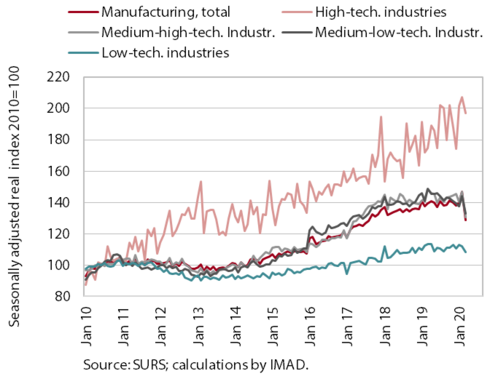
With the spread of the coronavirus, manufacturing output declined sharply in the EU and Slovenia in March. The decline was similar to that at the beginning of the economic crisis at the end of 2008. It was attributable to lower foreign demand, interrupted supply chains and the shutdown of production in some companies after the declaration of the epidemic in Slovenia. Production fell the most in medium-low- and medium-high-technology industries. In high- and low-technology industries, the decline was more modest, but in our estimation, mostly thanks to a few individual, less affected industries (the pharmaceutical industry and the food industry).
Construction, March 2020
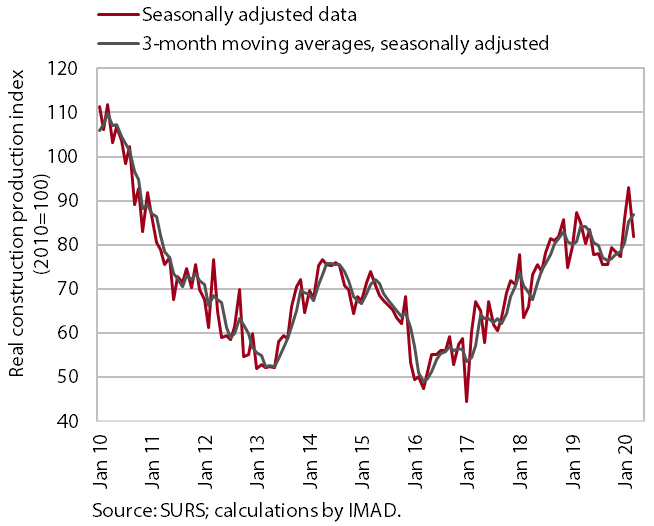
After a strengthening at the beginning of the year, construction activity declined in March with the declaration of the epidemic and the adoption of measures to contain its spread. In March, the value of construction output fell in all construction segments, the most in the construction of civil-engineering works (-17.6%) and less in the construction of residential (-5.5%) and non-residential buildings (-4.4%). On account of the high activity in the first two months, the value of construction output in the first quarter as a whole was in fact as much as 10.8% higher than in the last quarter of last year. In all three construction segments, the contract indicators also fell sharply in March, the least in civil engineering works.
Registered unemployment, April – May 2020
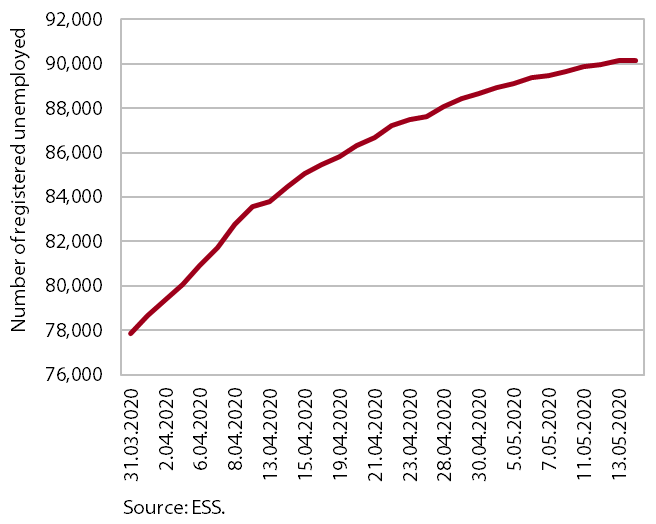
The number of registered unemployed persons started to increase markedly in the middle of March with the adoption of measures to contain the coronavirus epidemic, but in the last weeks, its growth has eased considerably. By the end of April, the number of unemployed persons had risen to 88,648, which is 19.9% more than one year earlier. Between the end of April and the middle of May, it increased further, by around 1,500 persons according to EES unofficial (daily) data. Among the newly registered, the number of those who lost work because their fixed-term employment contracts were not extended (a reason more frequently cited among younger age groups) or for business reasons was significantly higher than before the outbreak of the epidemic. The largest inflow into unemployment came from accommodation and food service activities, trade and manufacturing. In the last few weeks, the rise in the number of unemployed persons has eased noticeably, which is related to the resumption of some activities, the expected further easing of containment measures and the adoption of the second legislative package to mitigate the economic impact of the crisis.
Traffic of electronically tolled vehicles on Slovenian motorways, April – May 2020
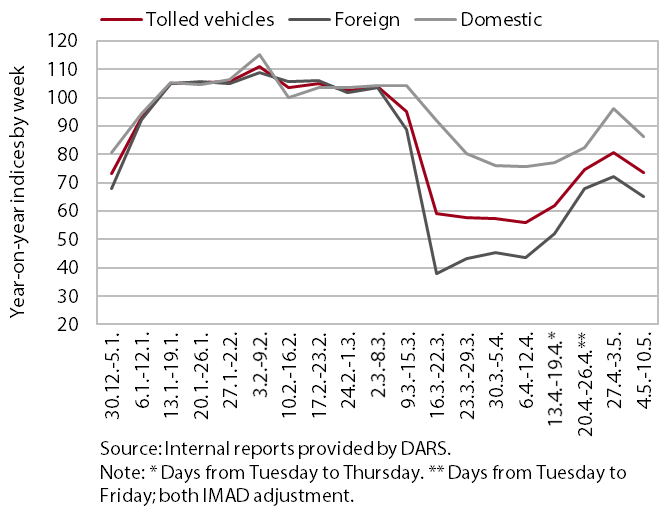
Freight traffic on Slovenian motorways, which fell markedly after the adoption of measures to contain the epidemic spread, was rising gradually from mid-April to May. After a nearly 40% decline in the first few weeks, it was a good quarter lower year on year in the week after the Labour Day holiday. The distance of journeys performed by foreign trucks was still more than a third lower than one year before, while that performed by domestic trucks declined significantly less. The decline in foreign truck traffic, at first significantly more pronounced than in domestic truck traffic, has decreased under the impact of EU measures to ensure the free flow of goods across borders and due to the easing of measures in some neighbouring countries.
Electricity consumption, May 2020
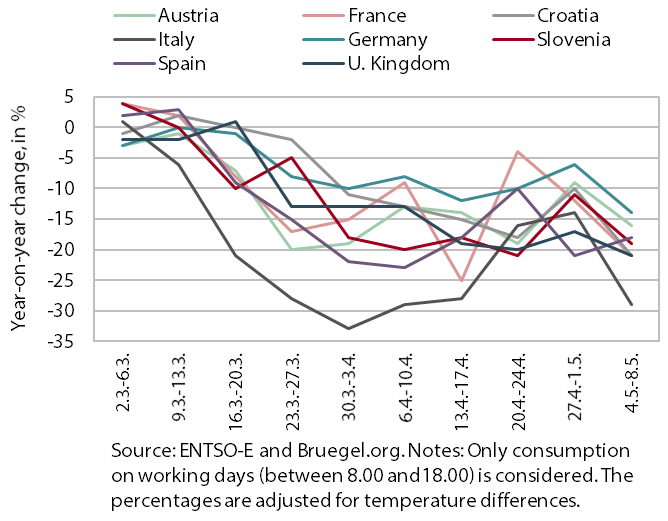
In the first week of May, the year-on-year fall in weekly electricity consumption in Slovenia remained approximately the same as in April. Electricity consumption, which is one of the indicators of economic activity, was around 19% lower year on year in the first week of May. Despite the relaxation of a number of containment measures, the decline in consumption was similar to that in the previous weeks since the beginning of April (the Labour Day holiday week excluded). In some other countries, the decline in consumption increased slightly again at the beginning of May, after the decrease in April. In Italy, consumption was almost 30% lower, which is similar to the first half of April, when very strict measures applied. Germany also stands out with a 14% decline in consumption, the largest since the beginning of the crisis.
Current account, March 2020
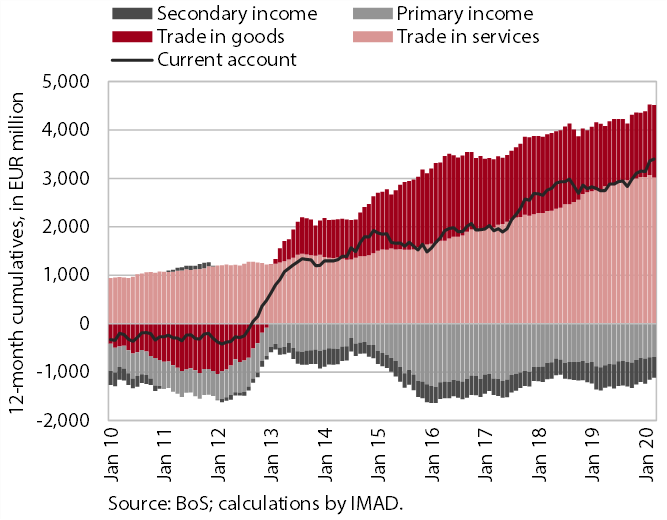
The measures to stem the spread of the epidemic had a significant impact on external trade in goods and services in the first quarter, while in other current account segments their impact was not yet perceived. In the first quarter, the current account surplus was higher year on year again. Its growth was mainly driven by the surplus in trade in goods. This was to a great extent attributable to developments in March, when goods trade fell significantly due to the adopted measures, with imports declining more than exports. After several years of growth, the surplus in services was lower year on year in the first quarter, particularly in trade in travel services and in air and railway transport. Net outflows of primary income dropped further, mostly owing to lower net payments of income on equity and interest on external debt. The lower net outflows of secondary income were marked especially by higher payments into the EU budget
